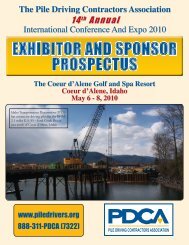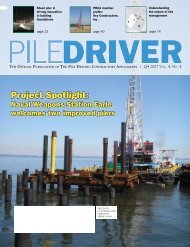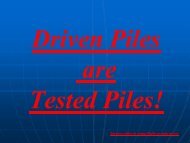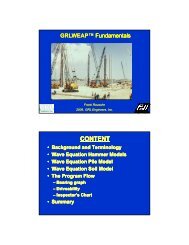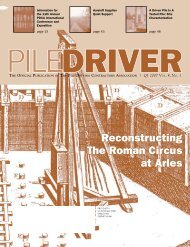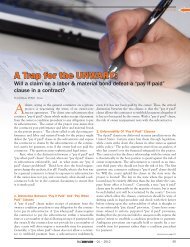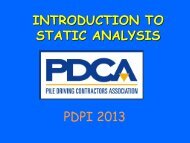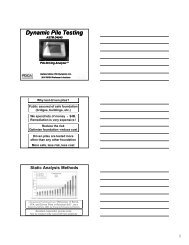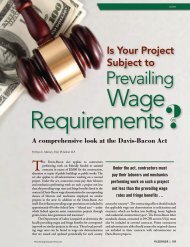Full Issue (17 MB) - Pile Driving Contractors Association
Full Issue (17 MB) - Pile Driving Contractors Association
Full Issue (17 MB) - Pile Driving Contractors Association
You also want an ePaper? Increase the reach of your titles
YUMPU automatically turns print PDFs into web optimized ePapers that Google loves.
Monitoring <strong>Pile</strong> <strong>Driving</strong><br />
Vibrations – Problem Avoidance<br />
By David Harrison<br />
In today’s legal environment, protecting pile driving projects<br />
from fraudulent or errant claims resulting from vibrations<br />
produced from pile driving construction activities is<br />
important. This can be achieved with good science and data<br />
collection prior to and during pile driving activities.<br />
Ground vibration is essentially wasted energy - not all of<br />
the energy from the pile driving hammer goes into driving the<br />
pile in the ground. Some wasted energy is released as ground<br />
vibrations, air concussion and noise. The primary concern<br />
with ground vibration is its potential to damage surrounding<br />
properties. It is important to distinguish between structural<br />
damage and damage that is of a cosmetic nature.<br />
Seismographs should be used to monitor ground vibrations<br />
and impulse noise levels. These instruments continuously<br />
monitor the two horizontal and one vertical component<br />
of motion and record the maximum. The maximum resultant<br />
vector of velocity in these three directions is called the Peak<br />
Particle Velocity (PPV) and is the main output parameter<br />
reported by the seismograph. PPV is typically measured in<br />
inches per second.<br />
Overpressure is the acoustic parameter measured by the<br />
seismograph and is measured in decibels indicated by the symbol<br />
dB(L).<br />
Another measurement tool is human perception People<br />
can feel vibrations well below those levels necessary to cause<br />
damage, and as such, human perception should not be used as<br />
an indicator of the damage potential of vibrations.<br />
AREAS OF CONCERN<br />
Areas of concern for vibrations from pile driving operations<br />
include building damage, soil settlement, buried utilities,<br />
human perception, toppling of loose objects and sensitive<br />
equipment and computers.<br />
Damage Potential to Buildings<br />
Vibration standards are in units of particle velocity with<br />
frequency dependency. These standards are designed to protect<br />
drywall and plaster from cosmetic cracking; structural<br />
damage would require two to five times higher vibrations than<br />
the generally applied standards.<br />
Vibration Standards-Transient (Impact Hammer)<br />
Below is a list of acceptable vibration limits for transient<br />
vibration levels for pile driving and other construction activities<br />
developed by the US Bureau of Mines (RI 8507):<br />
• Limits PPV to 19.05 mm/sec (0.75 in/sec) for low<br />
frequency vibrations (





